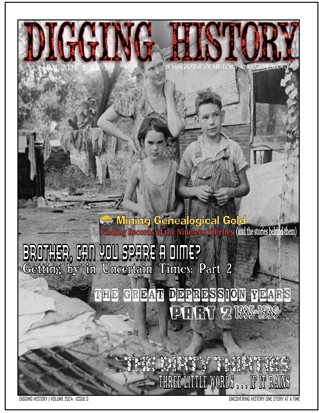Home / Shop
May-June 2024


- Description
- Customer Reviews (0)
This third issue of 2024 features articles which conclude an extended series on the 1930s, the Great Depression era:
● The Great Depression Years (1935-1939). This is a series of articles discussing the highlights (or low lights, as it were) of the last five years of the 1930s. By this time Franklin Roosevelt was creating program after program to stem the economic crisis. Some things worked and some didn’t. This extensive article includes excerpts from the archives, as well as new material, including “In Other News”, evidence that the 1930s wasn’t all about The Great Depression.
● Mining Genealogical Gold: Finding Records of the Nineteen Thirties (and the stories behind them). Despite the dismal economic situation which presented America with challenges it had never faced in its history, coupled with other devastating disasters like the Dust Bowl, the 1930s are rich with “genealogical gold”, much of it as a direct result of Franklin Roosevelt’s New Deal. This article highlights the genealogically-rich slave narratives as well as an overview of a valuable web site about the New Deal.
● The Dirty Thirties (Part 2): Three Little Words . . . If It Rains. Three little words – achingly familiar on a western farmer’s tongue – rule life today in the dust bowl of the continent – If it rains . . . Much of this article is drawn from the writings of one Oklahoma “No Man’s Land” homesteader, Caroline Boa Henderson, one of the best records of what it was like living through the Dust Bowl years and the aftermath it left behind.
● Brother Can You Spare a Dime?: Getting By in Desperate Times: Part 2. The Great Depression was no respecter of location or culture – the vast majority of Americans were affected to one degree or another. However, it’s interesting to discuss notable differences in how urban residents, who had become accustomed to city life (easy access to food, fashion and culture, etc.), coped vs. how rural folks managed to eke out a living and feed and clothe their families. It was a stark contrast – in cities those in need depended more heavily on charity and the government, while in rural areas, where “country folks” had historically been more self-sufficient, it was still rather challenging, especially if you lived in the “Dust Bowl”. Two topics in particular stand out – putting food on the table and frugal fashion.
Enjoy the issue! As always, I am grateful for my faithful subscribers. You are a blessing to me!
Sharon Hall, Publisher and Editor